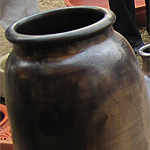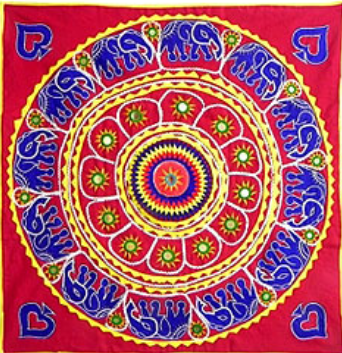A variety of earthen objects such as pitchers, flower vases, pots, cut-work lamps, Matka-water pot, Surahi- the narrow necked pot, Gamla- flower pots , lanterns, cutwork lamps, Handi-cooking utensil, Parat-larger platters, gulaks, chillums, handis, musical instruments Diya-oil lamps, Aarti lamps used in rituals, idols and figures of gods and goddesses, large garden pots, patterned tiles, roof tiles, urlis, etcall made of light red clay which boasts a cooling effect can be found in abundance.
A large number of the potters in Delhi have migrated from the neighboring states of Haryana, Rajasthan and Uttar Pradesh Rajasthan. They are located in Govindpuri and Hauz Rani: Kumbhar Basti. A number have settled in the Prajapati Colony in Uttam Nagar that was set up in the 1970’s to house the potters. As most of the potters had names connected with their caste occupation the colony was called Prajapati. Currently over 400 families practicing this craft in the colony and provide their products across Delhi and NCR.
The methods adopted by the potters are similar to those employed in the pottery tradition(s) of their ancestral place. Black, red, and yellow clay in the form of small pieces is obtained from Rajasthan and Delhi. This is mixed and dried, after which water is added to it. The resulting mixture of wet clay is filtered through a fine sieve to remove pebbles. After the clay has been kneaded into homogenous flexible dough, the prepared clay is made into a variety of artifacts using either the throwing technique. Coiling technique is used in making large products that are too large to be thrown on the wheel and to make those with shapes that cannot be turned on the wheel. After giving shape to the item and drying it in the shade, it is baked in the kiln. The potters specialize in making particular products and have specialize in what they do.
Their tools are rudimentary and include the the Kumbhar chaak or potter’s wheel, the electric wheel, the Khuriya or turning tool, the Mogri wooden mallet , Sua or incising needle, the Thapi wooden beater, Thapa – the large beater, Maniya or die and the Katni carving tool.
Gallery
YOUR VIEWS
PRACTITIONERS: INDIA
Access 70,000+ practitioners in 2500+ crafts across India.
BIBLIOGRAPHY
10,000+ listings on arts, crafts, design, heritage, culture etc.
GLOSSARY
Rich and often unfamiliar vocabulary of crafts and textiles.
SHOP at India InCH
Needs to be written.






